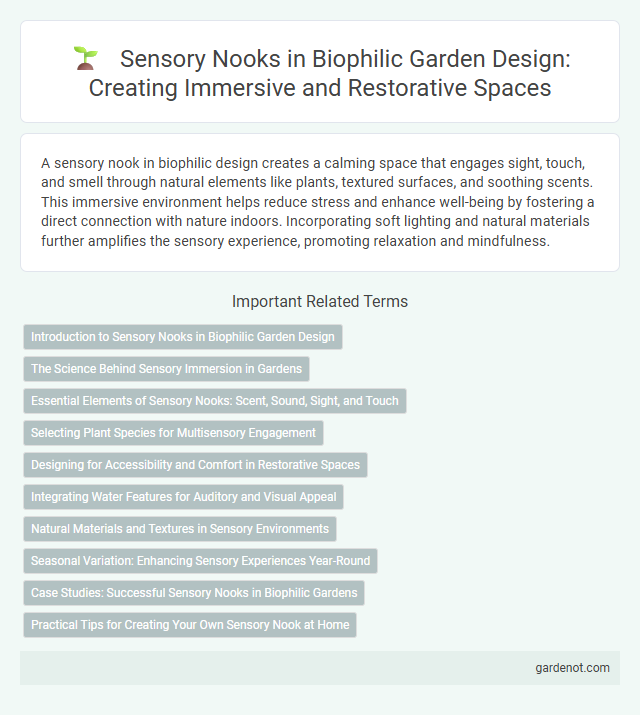A sensory nook in biophilic design creates a calming space that engages sight, touch, and smell through natural elements like plants, textured surfaces, and soothing scents. This immersive environment helps reduce stress and enhance well-being by fostering a direct connection with nature indoors. Incorporating soft lighting and natural materials further amplifies the sensory experience, promoting relaxation and mindfulness.
Introduction to Sensory Nooks in Biophilic Garden Design
Sensory nooks in biophilic garden design create immersive environments that engage sight, sound, touch, smell, and taste to foster emotional well-being and connection to nature. These specialized spaces incorporate natural elements such as textured plants, aromatic herbs, water features, and tactile materials to stimulate the senses and promote mindfulness. Integrating sensory nooks enhances restorative experiences and supports cognitive health by encouraging users to slow down and appreciate the natural world.
The Science Behind Sensory Immersion in Gardens
Sensory nooks in biophilic garden design harness the science of sensory immersion by engaging multiple senses--sight, sound, smell, touch, and sometimes taste--to foster psychological restoration and reduce stress. Research indicates that multisensory exposure to natural elements activates the parasympathetic nervous system, lowering cortisol levels and enhancing mental clarity. Strategic placement of fragrant plants, textured surfaces, and water features creates a microenvironment that maximizes nature's therapeutic effects on human cognition and well-being.
Essential Elements of Sensory Nooks: Scent, Sound, Sight, and Touch
Sensory nooks in biophilic design integrate essential elements such as natural scents from plants or essential oils, soothing sounds like flowing water or bird calls, visually calming views of greenery or natural textures, and tactile materials including soft wood or smooth stones. These sensory cues enhance well-being by creating immersive environments that connect occupants with nature. Incorporating scent, sound, sight, and touch in sensory nooks supports stress reduction, cognitive restoration, and overall emotional balance.
Selecting Plant Species for Multisensory Engagement
Selecting plant species for a sensory nook involves prioritizing varieties that stimulate multiple senses, such as fragrant herbs like lavender and rosemary for scent, textured succulents for touch, and visually vibrant flowering plants like orchids or fuchsias. Incorporating diverse foliage shapes, colors, and sizes enhances visual interest and supports tactile exploration. Including plants that attract wildlife, such as butterflies or hummingbirds, further enriches the sensory experience through natural movement and sound.
Designing for Accessibility and Comfort in Restorative Spaces
Sensory nooks in biophilic design prioritize accessibility and comfort by integrating natural textures, adjustable lighting, and acoustic elements to support diverse sensory needs. Incorporating ergonomic seating and tactile features enhances restorative experiences for individuals with sensory processing challenges. These thoughtfully designed spaces foster inclusive environments that promote relaxation and well-being in both residential and healthcare settings.
Integrating Water Features for Auditory and Visual Appeal
Incorporating water features into sensory nooks enhances auditory tranquility and visual serenity, essential elements of biophilic design that promote relaxation and mental clarity. The gentle sound of flowing water stimulates the auditory senses while the reflective surfaces create dynamic visual interest, linking indoor spaces with nature. Strategically placed fountains, small ponds, or cascading streams can improve air quality and humidity, further enriching the sensory experience within these intimate, nature-inspired environments.
Natural Materials and Textures in Sensory Environments
Natural materials and textures enhance sensory nooks by stimulating tactile and visual senses, promoting relaxation and connection to nature. Incorporating wood grains, stone surfaces, and plant fibers creates a multisensory environment essential for biophilic design principles. These elements improve mood and reduce stress by mimicking natural settings within indoor sensory environments.
Seasonal Variation: Enhancing Sensory Experiences Year-Round
Seasonal variation in sensory nooks enriches biophilic design by integrating changing natural elements like autumn leaves, spring blooms, and winter snow textures to stimulate sight, touch, and smell. Incorporating diverse plant species and materials that respond to seasonal shifts promotes year-round engagement and emotional well-being. Dynamic sensory experiences aligned with nature's cycles foster deeper connections to the environment and enhance spatial comfort throughout the year.
Case Studies: Successful Sensory Nooks in Biophilic Gardens
Case studies of successful sensory nooks in biophilic gardens highlight multisensory engagement through elements like textured plants, aromatic herbs, and natural soundscapes, enhancing users' connection to nature. Notable examples include the Singapore Botanic Gardens' Tanglin Core, where tactile and olfactory experiences promote relaxation and mindfulness. These sensory nooks demonstrate the effective integration of biophilic principles, improving well-being and environmental awareness.
Practical Tips for Creating Your Own Sensory Nook at Home
Create a sensory nook by incorporating natural elements such as textured plants, wooden furniture, and soft, earth-toned fabrics to stimulate tactile and visual senses. Use adjustable lighting with warm tones to mimic natural sunlight, enhancing relaxation and mood regulation. Include sensory-responsive items like wind chimes or water features to engage auditory senses and foster a calming environment.
Sensory nook Infographic

 gardenot.com
gardenot.com